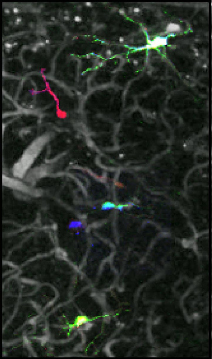Long-term in vivo single-cell tracking reveals the switch of migration patterns in adult-born juxtaglomerular cells of the mouse olfactory bulb.
 The behavior of adult-born cells can be easily monitored in cell culture or in lower model organisms, but longitudinal observation of individual mammalian adult-born cells in their native microenvironment still proves to be a challenge. Here we have established an approach named optical cell positioning system for long-term in vivo single-cell tracking, which integrates red-green-blue cell labeling with repeated angiography. By combining this approach with in vivo two-photon imaging technique, we characterized the in vivo migration patterns of adult-born neurons in the olfactory bulb.
The behavior of adult-born cells can be easily monitored in cell culture or in lower model organisms, but longitudinal observation of individual mammalian adult-born cells in their native microenvironment still proves to be a challenge. Here we have established an approach named optical cell positioning system for long-term in vivo single-cell tracking, which integrates red-green-blue cell labeling with repeated angiography. By combining this approach with in vivo two-photon imaging technique, we characterized the in vivo migration patterns of adult-born neurons in the olfactory bulb.
In contrast to the traditional view of mere radial migration of adult-born cells within the bulb, we found that juxtaglomerular cells switch from radial migration to long distance lateral migration upon arrival in their destination layer. This unique long-distance lateral migration has characteristic temporal (stop-and-go) and spatial (migratory, unidirectional or multidirectional) patterns, with a clear cell age-dependent decrease in the migration speed. The active migration of adult-born cells coincides with the time period of initial fate determination and is likely to impact on the integration sites of adult-born cells, their odor responsiveness, as well as their survival rate.Cell Research advance online publication 13 May 2016; doi:10.1038/cr.2016.55.
see more: http://www.nature.com/cr/journal/vaop/ncurrent/full/cr201655a.html
press release of the University Tübingen:
https://www.uni-tuebingen.de/aktuelles/pressemitteilungen/newsfullview-pressemitteilungen/article/live-beobachtet-entwicklung-neuer-nervenzellen-im-gehirn.html
- 68 views
